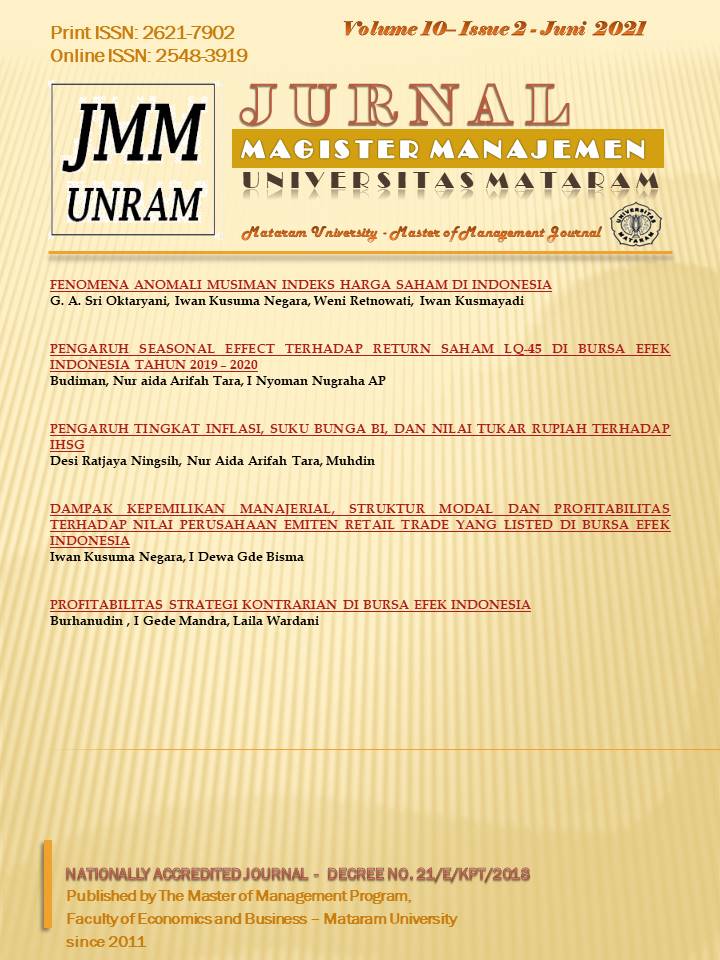PROFITABILITAS STRATEGI KONTRARIAN DI BURSA EFEK INDONESIA
DOI:
https://doi.org/10.29303/jmm.v10i2.657Abstract
The efficient market hypothesis implies that no investor can get an abnormal return. This hypothesis has become a research topic that many researchers refer to. However, this hypothesis is strongly refuted after the discovery of several anomalies that are inconsistent with the efficient market hypothesis. One of them was found by De Bondt and Thaler (1985), that stock prices have a certain tendency, namely that stocks that perform well in one period will become stocks that perform poorly in the next period. Vice versa. This phenomenon is called overreaction or overreaction. These findings motivated further researchers to apply contrarian strategies to gain an advantage when there was an overreaction. This research is a study that is intended to obtain evidence of the ability of contrarian strategies in obtaining abnormal returns. This study aims to analyze the occurrence of overreaction on stocks on the Indonesia Stock Exchange and to analyze the advantages of implementing a contrarian strategy for investors. This research was conducted at companies listed on the Indonesia Stock Exchange. The companies selected were 100 companies with the most active transactions during 2019. From the results of data analysis, it can be concluded that there was a price reversal for the shares listed on the Indonesia Stock Exchange. This result is quite strong because it has been tested for up to 4 weeks. Despite the price reversal, the contrarian strategy was not able to generate significant returns for investors.References
Akhigbe, A., T. Gosnell dan T. Harikumar (1998), Winners and Losers on NYSE: A Re-Examination Using Daily Closing Bid-Ask Spread, Journal of Financial Research, Vol. 21, 53-64
Aktas, H. Dan Semra Oncu (2006), The Stock Market Reaction to Extreem Events: The Evidence from Turkey, International Research Journal of Finance and Economics, Issue 6, 78-85
Atkins, A.B. dan E.A. Dyl (1990), Price Reversal, Bid-Ask Spreads and Market Efficiency, Journal of Financial and Quantitative Analysis, Vol.25, 535-547
Ball, R., S. Kothari dan J. Shanken (1995), Problems in Measuring Portfolio Performance: An Application to Contrarian Investment Strategies, Journal of Financial Economics, Vol. 38, 79-107
Bowman,R.G. dan D. Iverson (1998), Short-run Overreaction in The New Zealand Stock Market, Pacific Basin Finance Journal, Vol.6, 475-491
Brown, K. dan W. Harlow (1988), Market Overreaction: Magnitude and Intensity, Journal of Portfolio Management, Vol. 14, 6-13
Chang, R.P, D.W, McLeavey dan S.G. Rhee (1995), Short-term Abnormal Returns of The Contrarian Strategy in The Japanese Stock Market, Journal of Business Finance and Accounting, No. 22
Chopra, N., J. Lakonishok dan J.R. Ritter )1992), Measuring Abnormal Performance, Journal of Financial Economics, Vol. 31, 235-268
Cox, D. dan D. Peterson (1994), Stock Returns Following Large One-day Declines: Evidence on Short-Term Reversals and Longer-Term Performance, The Journal of Finance, 49, 255-267
De Bont, W.F. dan R. Thaler (1985), Does The Stock Market Overreact?, The Journal of Finance, 40, 793-805
Hameed, A dan S. Ting (2000), Trading Volume and Short-Horizon Contrarian Profit: Evidence from Malaysian Stock Market, Pacific-Basin Finance Journal, No. 8
Howe, J (1986), Evident on Stock Market Overreaction, Financial Analysts Journal, Vol. 42, 74-77
Jogiyanto. Hartono 2014. Teori Portofolio dan Analisis Investasi, Yogyakarta: BPFE-UGM
Kang, J , M.H. Liu dan S. X. Ni (2002), Contrarian and Momentum Strategies in The China Stock Market: 1993-2000, Pacific-Basin Finance Journal, No. 10
Larson, Stephen J. dan Jeff Madura (2003), What Drives Stock Price Behavior Following Extreme One-Day Returns, The Journal of Financial Research, Vol. 25, No.1, 113-127
Otchere, Isaac dan Jonathan Chan (2003), Short-Term Overreaction in Hong Kong Stock Market: Can Contrarian Trading Strategy Beat The Market?, The Journal of Behavioral Finance,Vol.4, No.3, 157-171
Zarowin, P (1990), Size, Seasonality, and Stock Market Overreaction, Journal of Financial and Quantitative Analysis,Vol. 25, 113-125
https://www.teguhhidayat.com/2014/01/mengenal-strategi-kontrarian.html
Downloads
Published
How to Cite
Issue
Section
License
Copyright (c) 2021 JMM UNRAM - MASTER OF MANAGEMENT JOURNAL

This work is licensed under a Creative Commons Attribution 4.0 International License.
- Authors retain copyright and grant the journal right of first publication with the work simultaneously licensed under a CC BY 4.0. This license allows authors to use all articles, data sets, graphics, and appendices in data mining applications, search engines, web sites, blogs, and other platforms by providing an appropriate reference. The journal allows the author(s) to hold the copyright without restrictions and will retain publishing rights without restrictions.
- Authors are able to enter into separate, additional contractual arrangements for the non-exclusive distribution of the journal's published version of the work (e.g., post it to an institutional repository or publish it in a book), with an acknowledgment of its initial publication in JMM.
- Authors are permitted and encouraged to post their work online (e.g., in institutional repositories or on their website) prior to and during the submission process, as it can lead to productive exchanges, as well as earlier and greater citation of published work (See The Effect of Open Access).










